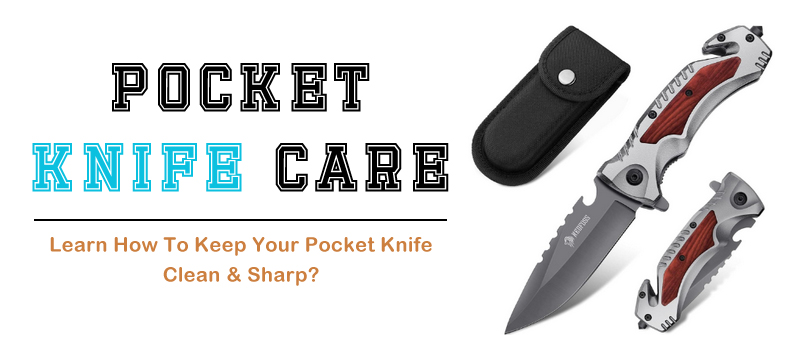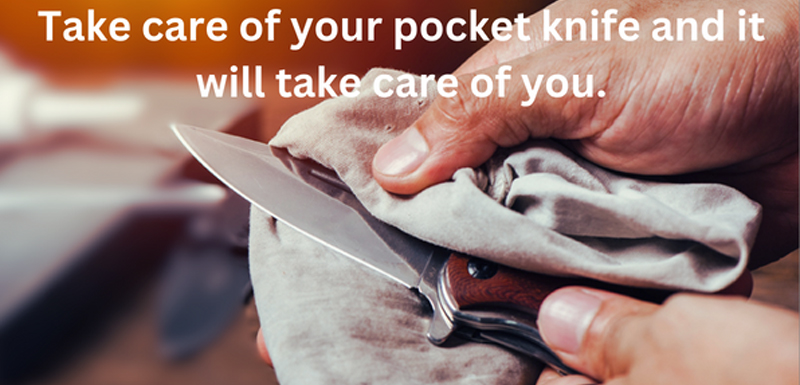A pocket knife is an essential tool for any camper or backpacker and serves a variety of purposes outdoors. From slicing food to trimming twigs for kindling and even self-protection, a pocket knife can be an outdoors person's best friend and is an important part of their survival gear and tools.
However, a pocket knife will only serve its purpose if it's clean and sharp.
That's why it's important to take proper care of it, and this includes knowing how to clean & sharpen a pocket knife properly and thoroughly.

Cleaning & sharpening a pocket knife takes some effort, but it really isn't all that difficult.
The process can be a little trickier for pocket knives with wooden handles and those that have developed rust, but we'll discuss that in detail later in this article.
Before you continue, don't miss our in-depth guide on the 7 Best Pocket Knives—tested, reviewed. Trust us, these picks are a cut above the rest!
Let's come back to the topic...

To clean your pocket knife, you're going to need the following items, all (or at least most) of which can be found right around your house.
Your pocket knife is bound to accumulate lint and gunk over time, particularly around the pivot screw, the sleeve (where the blade hides when the knife is closed), and in the grooves between the handle grips and the handle body.
Sometimes, when a knife has trouble opening or closing, the problem is usually caused by lint and gunk getting stuck in the pivot screws, so cleaning them out should solve the problem.
It is recommended that you use a round toothpick instead of a flat one to pry the lint and gunk out. Round toothpicks have pointier ends than flat toothpicks and don't break easily. Also, be sure to do this with a dry knife. Wetting the lint and gunk sometimes makes them harder to clean out.
After removing the lint and gunk, go to a sink and rinse the knife using warm water. Make sure that you run the warm water inside the sleeve as well to flush out loose lint, gunk, and dirt.
Put a drop of mild detergent on the toothbrush (don't put the detergent directly on the knife), and then gently scrub the entire knife with it. Start with the blade, including the spine, and work your way to the handle. Be sure to wash every edge and groove and remove any crud, dirt, or sand. You can use cotton buds to clean the inside of the handle and the hard-to-reach corners there.
Be careful when handling the knife as you brush it. It may slip from your hands, and you'll end up cutting yourself.
After scrubbing the knife and you're satisfied that you've cleaned out every dirt and debris from the blade, handle and other parts, then it's time to rinse and wash away the soap.
You'll want to use warm water because this is much more effective when it comes to removing oils and soap residue than cold water. Also, don't just run the knife under flowing water. Instead, gently rub the knife with your fingers or a towel to ensure that you remove all the oils and soap residue.
Once you get all the oils and soap residue out, dry your pocket knife using a dry rag or paper towel. Be sure that you wipe away all droplets of water from the blade; otherwise, they will leave some unsightly watermarks. You can also use some of the cotton buds to clean the blade sleeve since this area will be difficult to reach with a rag or paper towel.
It would be best if you got all traces of moisture out to keep your pocket knife from developing rust. Also, be very careful when drying your knife to prevent cutting your fingers.
After wiping your pocket knife dry, leave it open and let it air dry for a few minutes or until you're satisfied that it has fully dried.
Check that the knife is fully dried before applying lubricant to it. There are some knife-specific lubricating products sold in the market, but you can also use sewing machine oil, gun oil, or other similar items instead. Apply the lubricant to the pivot screw, the blade, and other moving parts of your pocket knife.
Use the lubricant sparingly because a small amount can go a long way. Using too much will also make the knife too oily and slippery even days after you clean your pocket knife.
Once you lubed the blade and all the moving parts, wipe away any excess oils using a dry rag or a paper towel.

Just because your pocket knife is made from stainless steel doesn't mean that it won't rust. As the name suggests, it's "stainless," not "stain-proof.""" It will rust much less frequently and less severely than iron, but it will still develop rust when not cared for properly.
Rust begins on the surface of the pocket knife and works its way inwards. From there it corrodes the metal and will ultimately lead to the deterioration of the blade.
If your pocket knife has developed rust, you'll first want to check how severely rusted the metal is. If the rust appears to be a thin layer on the metal's surface, then you should be able to remove the rust easily and still have a great-looking pocket knife afterward.
If the rusting is so severe that it has started eating through the metal, then consider putting it away and getting yourself a brand-new pocket knife.
IF the rusting is just light, then you can use those rust removal products being sold in the market. Be careful to read the instructions and follow them to get the most out of it. Depending on how severe the rusting is, it may take a few tries before you get the rust out completely. Be patient, though, and give it some time.
After you've gotten all the rust out, clean and wipe your pocket knife. Be sure to thoroughly dry your knife because you don't want to leave any bit of moisture, considering that it is how rusting begins in the first place.
Some of the prettiest pocket knives have wooden handles, and if you have such a knife, then you'll want to put extra effort into taking care of it. For one, you'll want to make sure that you don't soak the handles in water, regardless of how dirty it is.
Excessive moisture will cause your wooden handles to warp and crack and even lead to the development of wood rot. Also, you'll want to wipe the wooden handles with mineral oil or linseed oil. Doing so gives it extra protection against moisture. It also keeps your wooden handles shiny and looking great.
As much as possible, avoid taking your pocket knife apart when cleaning it. Some people think that they need to do so to clean their pocket knives properly, and though this may be true to some degree, it comes with several consequences that may end up doing more harm than good to your pocket knives.
For one, it may void the warranty that came with the pocket knife when you purchased it. Some pocket knife manufacturers are fairly strict concerning taking apart their products, especially when it's not done by certified personnel.
Second, you may have trouble putting the knife back together after taking it apart. Everyone knows that it is much easier to take apart things than to put them back together. Besides, some pocket knives will require specialized tools to dismantle and build.
If your pocket knife needs to be dismantled, check your warranty documents first. Some pocket knife manufacturers have excellent warranties and will gladly fix your pocket knife for you if you send it back to them. They will take the knife apart, clean every part thoroughly, and even sharpen the blade before sending it back to you.
More important than having a pocket knife, though, is knowing how to take care of it, and it all starts with learning how to clean a pocket knife. Cleaning a pocket knife may sound tedious, but it actually isn't.
And all the effort you put into doing so will definitely be more than worth it. As with any other tool, take care of your pocket knife, and it will take care of you.

There are a lot of ways you can sharpen a pocket knife. Different tools and techniques are used and all of them usually give similar results. We will show you how to sharpen a pocket knife easily. This technique is good for beginners and for those who are looking for something basic. The most important thing is that this method works.
Before you start sharpening a pocket knife, consider what you are going to use it for. There are different methods of sharpening for cooking, whittling, cutting, etc. Your pocket knife doesn't have to be as sharp as an expensive chef knife, so there's no need to use costly sharpeners for it.
Your knife should be sharpened properly and ready for use once you're done with the fine grit.
Q: What is the best knife sharpening method?
Ans: Although there are many different techniques and methods for sharpening a pocket knife, using the knife sharpener is still the number one. It is also the easiest to do it with a knife sharpener for numerous reasons. Traditional methods are still useful but need to be more effective.
Q: How do you sharpen a knife without a sharpening stone?
Ans: Sharpening a knife without a stone or a knife sharpener is dangerous, so be careful not to get hurt. Still, if you're in need, you can use a porcelain plate or a mug to get your knife a bit sharper. Turn the plate upside down and make strokes at the bottom side.
Q: Do you sharpen both sides of a knife?
Ans: Yes, you need to sharpen both sides of a knife to achieve the best results. On the other hand, if you don't sharpen both sides, you may not get the optimal sharpening effect. Also, you will be risking bending the cutting surface of the blade, damaging your knife permanently.
Q: Can you sharpen a knife with sandpaper?
Ans: Yes, it is possible to sharpen a knife with sandpaper. In fact, it is recommended to learn how to sharpen a pocket knife with sandpaper before you try doing it with a knife sharpener. Hold the blade at a 22-degree angle and make gentle strokes over the sandpaper. Apply mild pressure and push the knife away from you.
Having a clean & sharp pocket knife is necessary for a couple of reasons, such as safer cuts and easier and faster cutting. It is a very easy process that requires effort and time.
Keep in mind that no matter if you're using a sharpening stone, knife sharpener, or sandpaper, safety comes first.
Don't apply too much pressure, and make sure you push the knife blade away from you to avoid accidental cuts.